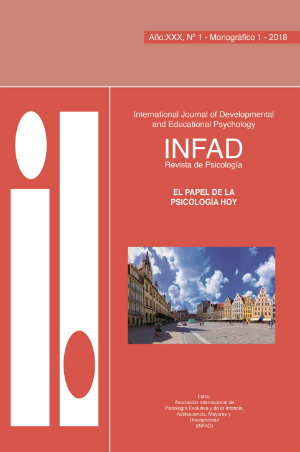La clase invertida en la educación superior: percepciones del alumnado
Contenido principal del artículo
Resumen
Detalles del artículo
Sección
Aquellos autores/as que tengan publicaciones con esta revista, aceptan los términos siguientes:
- Los autores/as conservarán sus derechos de autor y garantizarán a la revista el derecho de primera publicación de su obra, el cuál estará simultáneamente sujeto a la Licencia de reconocimiento de Creative Commons que permite a terceros copiar y redistribuir el material en cualquier medio o formato bajo los siguientes términos: —se debe dar crédito de manera adecuada, brindar un enlace a la licencia, e indicar si se han realizado cambios. Puede hacerlo en cualquier forma razonable, pero no de forma tal que sugiera que usted o su uso tienen el apoyo de la licenciante (Atribución); — no se puede hacer uso del material con propósitos comerciales (No Comercial); — si se remezcla, transforma o crea a partir del material, no podrá distribuirse el material modificado (Sin Derivadas).
- Los autores/as podrán adoptar otros acuerdos de licencia no exclusiva de distribución de la versión de la obra publicada (p. ej.: depositarla en un archivo telemático institucional o publicarla en un volumen monográfico) siempre que se indique la publicación inicial en esta revista.
- Se permite y recomienda a los autores/as difundir su obra a través de Internet (p. ej.: en archivos telemáticos institucionales o en su página web) antes y durante el proceso de envío, lo cual puede producir intercambios interesantes y aumentar las citas de la obra publicada. (Véase El efecto del acceso abierto).

Este obra está bajo una licencia de Creative Commons Reconocimiento-NoComercial-SinObraDerivada 4.0 Internacional.
Cómo citar
Referencias
Abeysekera, L. y Dawson, P . (2015). Motivation and cognitive load in the flipped classroom: Definition, rationale and a call for research. Higher Education Research & Development, 34 (1), 1-14.
Arum, R. y Roksa, J. (2011). Academically adrift: Limited learning on college campus es University of Chicago Press.
Bergmann, J. y Sams, A. (2012). Flip your classroom: Reachevery student in every class every day International Society for Technology in Education.
Betihavas, V., Bridgman, H., Kornhaber, R. y Cross, M. (2016). The evidence for ‘flipping out’: A systematic review of the flipped classroom in nursing education. Nurse Education Today, 38, 15-21.
Bunce, D. M., Flens, E. A. y Neiles, K. Y. (2010). How long can students pay attention in class? A study of student attention decline using clickers. Journal of Chemical Education, 87 (12), 14381443.
Coates, H. (2006). Student engagement in campus-based and online education: University connections Routledge
Cué, J. L. G., Rincón, J. A. S. y García, C. M. A. (2009). Uso de las TIC de acuerdo a los estilos de aprendizaje de docentes y discentes. Revista Iberoaméricana De Educación, 48 (2), 2.
Faundez, A. R. O., Bastias, J. M. A. y Polanco, M. P . R. (2016). Evaluación de metodología flipped classroom: Primera experiencia. Innoeduca. International Journal of Technology and Educational Innovation, 2 (2), 90-99
Furse, C. (2013). A busy professor’s guide to sanely flipping your classroom. Paper presented at the Antennas and Propagation Socity International Symposium (APSURSI), 2013 IEEE, 21712172.
Gilboy, M. B., Heinerichs, S. y Pazzaglia, G. (2015). Enhancing student engagement using the flipped classroom. Journal of Nutrition Education and Behavior, 47 (1), 109-114. doi: 10.1016/j.jneb.2014.08.008 [doi]
Kong, S. C. (2014). Developing information literacy and critical thinking skills through domain knowledge learning in digital classrooms: An experience of practicing flipped classroom strategy. Computers & Education, 78, 160-173.
Lewis, C. E., Chen, D. C. y Relan, A. (2018). Implementation of a flipped classroom approach to promote active learning in the third-year surgery clerkship. American Journal of Surgery, 215 (2), 298-303. doi: S0002-9610(17)30687-6 [pii]
Lo, C. K., Lie, C. W. y Hew, K. F. (2018). Applying “First principles of instruction” as a design theory of the flipped classroom: Findings from a collective study of four secondary school subjects. Computers & Education, 118, 150-165.
McLaughlin, J. E., Roth, M. T., Glatt, D. M., Gharkholonarehe, N., Davidson, C. A., Griffin, L. M., . . . Mumper, R. J. (2014). The flipped classroom: A course redesign to foster learning and engagement in a health professions school. Academic Medicine: Journal of the Association of American Medical Colleges, 89 (2), 236-243. doi:10.1097/ACM.0000000000000086 [doi]
Mok, H. N. (2014). Teaching tip: The flipped classroom. Journal of Information Systems Education, 25 (1), 7.
O’Flaherty, J. y Phillips, C. (2015). The use of flipped classrooms in higher education: A scoping review. The Internet and Higher Education, 25, 85-95.
Pierce, R. y Fox, J. (2012). Vodcasts and active-learning exercises in a “flipped classroom” model of a renal pharmacotherapy module. American Journal of Pharmaceutical Education, 76 (10), 196.
Roehl, A., Reddy, S. L. y Shannon, G. J. (2013). The flipped classroom: An opportunity to engage millennial students through active learning. Journal of Family and Consumer Sciences, 105 (2), 44.
Sams, A. y Bergmann, J. (2013). Flip your students’ learning. Educational Leader ship, 70 (6), 16-20.
Talbert, R. (2012). Inverted classroom. Colleagues, 9 (1), 7.
Tune, J. D., Sturek, M. y Basile, D. P . (2013). Flipped classroom model improves graduate student performance in cardiovascular, respiratory, and renal physiology. Advances in Physiology Education, 37 (4), 316-320.

